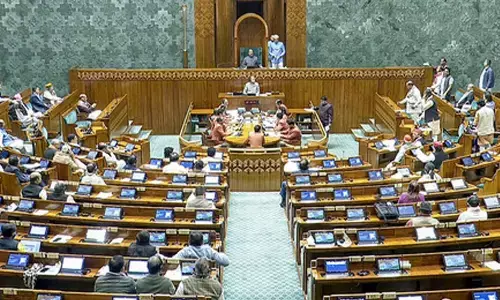Redesign green credit scheme

The green credit programme launched recently by the Centre is claimed as an innovative initiative to promote environment-friendly actions on a massive scale in order to build a sustainable future for the country.
The green credit programme launched recently by the Centre is claimed as an innovative initiative to promote environment-friendly actions on a massive scale in order to build a sustainable future for the country.
According to PIB, the Green Credit Rules, 2023, has been notified on 12th October 2023 under the Environment Protection Act 1986. These rules put in place a mechanism to encourage voluntary environmental positive actions resulting in issuance of green credits. In its initial phase, voluntary tree plantation is envisaged on degraded land, waste land, watershed area etc., under the control and management of Forest departments. The generation of Green Credit under Green Credit Rules, 2023 is independent of the carbon credit under Carbon Credit Trading Scheme 2023.
Eight important activities that have significant influence on environment such as tree plantation, water conservation, natural farming, waste management, pollution control, mangrove conservation and restoration and green building construction are chosen to be covered under this programme. With the release of rules by the ministry of environment and forest on 22nd February, 2024, the procedure for operation of green credits from tree plantation activity has become public while such action pertaining to other activities is still pending. These rules prescribe that the state forest departments identify degraded forest land parcels and take up plantations therein from the finances mobilised from the willing individuals and agencies.
Two years after planting by state forest departments concerned, the Indian Council of Forest Research and Education (ICFRE) assigns green credits after duly undertaking necessary evaluation. Such green credits earned by the individuals/ agencies can be used to offset their obligations under the Forest Conservation Act (FCA) and/or Corporate Social Responsibility (CSR) requirements.
Tree plantation, a
defective scheme
Though the programme is based on a laudable intention of achieving carbon neutrality and improving environment, the scheme of tree plantation is flawed on various counts. First, natural forests being typically multi-layered structures consisting of forest floor, herbs, shrubs, creepers, trees along with associated wildlife, the intervention of tree planting therein will be a misfit and cannot secure any improvement. In addition, tree planting is found to cause serious biodiversity loss, adverse impact on soil and water conservation, increase in soil carbon emission and reduction of overall carbon storage capacity of the forests.
The case studies from different parts of the world have shown evidence that tree plantations in natural forests lead to widespread damage to forests causing adverse effects on environment and livelihoods of indigenous people and other local communities (Friends of the Earth International, 2000). It is proven scientifically that natural forests have significantly higher capacity to sequester carbon as compared to plantation forests.
Second, the identification of degraded forest patches and assessment of degradation status poses a great challenge. Forests in our country support more than 200 types, each exhibiting its own unique characteristics. Many natural ecosystems appear as degraded forests if one sees from the point of view of tree density and wood productivity. For instance, tropical thorn forests, various grass land forests and other appear generally as degraded forests and taking up tree plantation there would cause serious ecological damage.
Third, the facility of using green credits to offset obligations under forest conservation act eases the process of diversion of forest lands for commercial purposes just with payment of planting expenses and by avoiding provisionof additional land for compensatory afforestation with resultant defeat of the very purpose of the act which is meant to achieve net zero emission. Moreover, this provision will facilitate increased number of unnecessary forest diversions leading to environmental catastrophe.
Fourth, there would be no incremental gain of carbon sequestration as the scheme is taken up in lieu of the existing compensatory afforestation rather than adding new greenery. There is nothing to show innovativeness in the scheme. Fifth, the objective of the scheme seems to be mobilisation of huge finances for tree planting in forests from private sources and the same does not stand to reason as the funds were never a sole limiting factor for expansion of the tree planting programme in forests.
Need of the hour
If tackling the forest degradation is taken as the priority, it is necessary to launch an appropriate forest restoration measure instead of standalone plantations. Regenerative forestry which involves multiple techniques of conservation, sustainable management, eco restoration, biodiversity conservation, soil protection, enhanced delivery ofecosystem services/products is gaining importance and widely accepted interventionto combat degradation and improve the forests in various parts of the world.
The concept entails a wider and holistic restoration culture with an integrated approach of involving wide cross section of people such as foresters, scientists, communities, local governments, private agencies and other. As this methodology aims at making the forests as diverse, resilient and self-sustaining systems it will be appropriate to promotethe same under green creditsprogramme.
When a massive programme like this is embarked in forests, it is essential to take into cognizance of the fact that the forests in our country have the highest dependence rate in the world (400 million people are dependent on forests, TERI, 2015) and there is an imminent need to provide a space for them to participate and gain benefit from the scheme. It would be meaningful if the programme incentivizes the forest dependent communitiesfor their efforts in strict protection, conservation, restoration, sustainable use of forests and contribution for ecological security of the country.
A recast of the scheme on these lines is an immediate necessity to accomplish the main goal of green credit programme.
(Writer is former Principal Chief Conservator of Forest &Head of Forest Force, Andhra Pradesh)
















